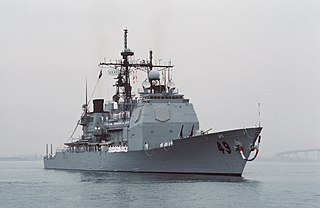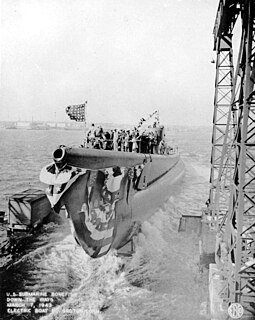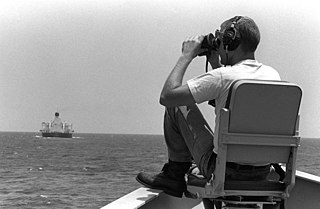
The Strait of Hormuz is a strait between the Persian Gulf and the Gulf of Oman. It provides the only sea passage from the Persian Gulf to the open ocean and is one of the world's most strategically important choke points. On the north coast lies Iran, and on the south coast the United Arab Emirates and Musandam, an exclave of Oman. The strait is about 90 nautical miles (167 km) long, with a width varying from about 52 nautical miles (96 km) to 21 nautical miles (39 km).

USS Thresher (SS-200), a Tambor-class submarine, was the most decorated United States Navy submarine of World War II. Her keel was laid down 27 May 1939 at the Electric Boat Company of Groton, Connecticut. She was launched on 27 March 1940 sponsored by Mrs. Margaret Cox Jones, wife of RADM Claud A. Jones and commissioned on 27 August 1940, with Lieutenant Commander William Lovett Anderson in command.

USS Vincennes (CG-49) was a Ticonderoga-class guided missile cruiser outfitted with the Aegis combat system that was in service with the United States Navy from July 1985 to June 2005. She was one of 27 ships of the Ticonderoga class constructed for the United States Navy, and one of five equipped with the Mark 26 Guided Missile Launching System.
This is a list of aviation-related events from 1984:

USS Bonefish (SS-223) was a Gato-class submarine, the first United States Navy ship to be named for the bonefish.

USS Farragut (DDG-99) is an Arleigh Burke-class destroyer in the United States Navy. She is the fifth Navy ship named for Admiral David Farragut (1801–1870), and the 49th ship of the Arleigh Burke class.

Operation Earnest Will was the American military protection of Kuwaiti-owned tankers from Iranian attacks in 1987 and 1988, three years into the Tanker War phase of the Iran–Iraq War. It was the largest naval convoy operation since World War II.

USS Haddock (SS-231), a Gato-class submarine, was the second submarine of the United States Navy to be named for the haddock, a small edible Atlantic fish, related to the cod. A previous submarine had been named Haddock (SS-32), but was renamed K-1 prior to her launching, so Haddock (SS-231) was the first to actually bear the name.
USS Tinosa (SS-283), a Gato-class submarine, was the first ship of the United States Navy to be named for the tinosa.

USNS Rappahannock is a Henry J. Kaiser-class underway replenishment oiler operated by the Military Sealift Command to support ships of the United States Navy.

The Battle of the Caribbean refers to a naval campaign waged during World War II that was part of the Battle of the Atlantic, from 1941 to 1945. German U-boats and Italian submarines attempted to disrupt the Allied supply of oil and other material. They sank shipping in the Caribbean Sea and the Gulf of Mexico and attacked coastal targets in the Antilles. Improved Allied anti-submarine warfare eventually drove the Axis submarines out of the Caribbean region.

HMS Sickle was a third-batch S-class submarine built for the Royal Navy during World War II. Completed in 1942, she made her initial war patrol off the Norwegian coast. Sickle then sailed to Gibraltar, from where she conducted one patrol, then to Algiers, French North Africa. From 10 May to 10 October, the boat patrolled the Gulf of Genoa five times and sank a German submarine as well as three minesweepers and an escort ship. She then moved to Beirut, French Lebanon, and conducted two patrols in the Aegean Sea, sinking three caïques and a merchant ship, in addition to landing resistance operatives in Greece.
The United Arab Emirates Navy is small force of about 2,500 personnel. It maintains 12 well-equipped coastal patrol boats and eight missile boats. Although primarily concerned with coastal defense, the Navy is constructing a six-unit class of blue water corvettes in conjunction with French shipbuilder CMN. The UAE maintains a small battalion-sized marine force called the UAE Marines equipped with BMP-3 armoured personnel carriers.

W. L. Steed was a steam tanker built in 1917–1918 by Bethlehem Shipbuilding Corporation of Quincy for Pan American Petroleum and Transport Company, with intention of transporting oil and petroleum products between Mexican and Gulf ports and the Northeast of the United States. The ship was briefly requisitioned by the US Government during World War I but returned to commercial service in early 1919. The ship was named after William L. Steed, superintendent of the Mexican Petroleum Company of California.

The Attack on Aruba was an attack on oil installations and tankers by Axis submarines during World War II. On 16 February 1942, a German U-boat attacked the small Dutch island of Aruba. Other submarines patrolled the area for shipping and they sank or damaged tankers. Aruba was home to two of the largest oil refineries in the world during the war against the Axis powers, the Arend Petroleum Maatschappij, situated near the Oranjestad harbor, and the Lago Oil and Transport Company at the San Nicolas harbor. The attack resulted in the disruption of vital Allied fuel production.
The Battle of Bubiyan was a naval engagement of the Gulf War, that occurred in the waters between Bubiyan Island and the Shatt al-Arab marshlands, where the bulk of the Iraqi Navy, while attempting to flee to Iran, much like the Iraqi Air Force, was engaged and destroyed by Coalition warships and helicopters.
India Arrow was a steam tanker built in 1921 by Bethlehem Shipbuilding Corporation of Quincy for Standard Oil Co., with intention of transporting oil and petroleum products between United States and the Far East. After serving for approximately ten years in the Pacific trade, the tanker was moved to intercoastal trade routes in early 1930s where she remained for the rest of her career. The vessel was torpedoed and sunk by the German submarine U-103 in February 1942 during one of her routine trips from Texas to New York with a loss of twenty six of her crew.
On 12 May 2019, four commercial ships were damaged off Fujairah's coast in the Gulf of Oman. The ships included two Saudi Arabian registered oil tankers, a Norwegian registered oil tanker, and an Emirati registered bunkering ship. The ships were anchored on the United Arab Emirates territorial waters for bunkering in Port of Fujairah. The Ministry of Foreign Affairs of the United Arab Emirates reported that the ships had been subject to a "sabotage attack". The United Arab Emirates launched a joint investigation probe with United States and France. The initial investigation assessment determined that 5-to-10-foot holes near or below all the ships' waterlines were probably caused by explosive charges.

On 13 June 2019, two oil tankers were attacked near the Strait of Hormuz while they transited the Gulf of Oman. The Kokuka Courageous, flagged in Panama and operated by a company based in Japan, and Front Altair, flagged in Marshall Islands and operated by a company based in Norway, were attacked, allegedly with limpet mines or flying objects, sustaining fire damage. American and Iranian military personnel responded and rescued crew members. The attacks took place a month after the similar May 2019 Gulf of Oman incident and on the same day the Supreme Leader of Iran Ali Khamenei met with Japanese Prime Minister Shinzō Abe in Iran. Abe was acting as an intermediary between American President Donald Trump and Iranian supreme leader, Ali Khamenei.

The 2019–2021 Persian Gulf crisis is an intensification of military tensions between the Islamic Republic of Iran and their allies and the United States of America and their allies in the Persian Gulf region. The U.S. began a buildup of its military presence in the region to deter an alleged planned campaign by Iran and its non-state allies to attack American forces and interests in the Persian Gulf and Iraq. This followed a rise in political tensions between the two countries during the Trump administration, which included the withdrawal of the U.S. from the Joint Comprehensive Plan of Action (JCPOA), the imposition of new sanctions against Iran, and the designation of the Islamic Revolutionary Guard Corps (IRGC) as a terrorist organization. In response, Iran designated the United States Central Command as a terrorist organization.














